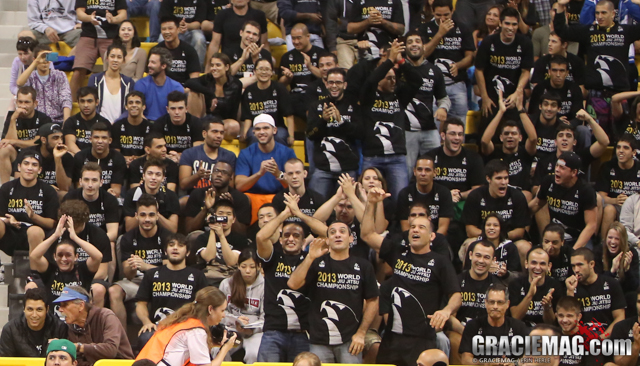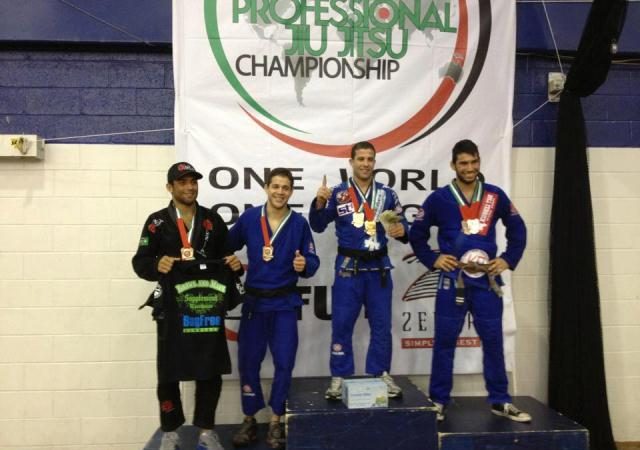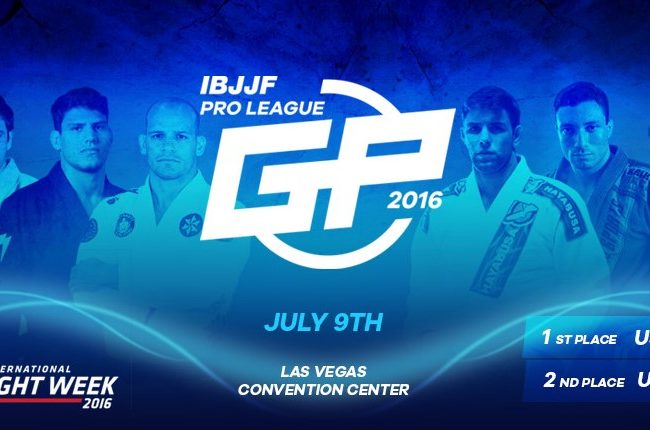If you want to be the adult male teams world champion, you need to have seven gold medalists among the 40 divisions that make the four belt ranks (blue, purple, brown, black).
Other than that, you’ll need seven second places and ten third places.
With all that, you will get 94 points as Alliance did last week at the 2013 Worlds.
Seven out of 40? That’s not much, isn’t it?
Yes it is a lot. It means to have one champion every 5.7 divisions, the same proportion for the runner ups and also to have one athlete in the third place every 4 podiums.
Overall, Alliance was present in 17 podium ceremonies with 21 athletes.
It’s almost half of the total number of ceremonies held at the adult male category (40).
In the black belt division alone, seven Alliance athletes reached one of the three steps of the podium.
Bernardo Faria was there twice (as third place in the absolute and as the super-heavyweight champion).
Fernando Andrade dos Reis was the only double gold athlete from Alliance, winning the purple belt open class and the heavyweight.
Here is the list of points by Alliance at each belt color:
Blue: 9+3+3+1+9+1 = 26
Purple: 9+1+3+1+3+9+9 = 35
Brown: 9+3+1 = 13
Black: 3+1+1+3+1+9+1+1 = 20
Total: 94
At the 2013 Worlds, Alliance scored 41pts more than second place Check Mat, which means that if the team hadn’t scored any points at the black belt division and all 20 points had gone to Check Mat, Alliance would still be the champion.
Alliance leader Fabio Gurgel talks a bit about the numbers: “You have to devote yourself to the technical foundation of Jiu-Jitsu and also get to know all of your affiliate members and team representatives. Our athletes do not come from one single place. We have athletes from Pouso Alegre, Brazil, Helsinki, Finland, and also from New York, USA, among many other places. We knew that the black belt competition would become increasingly fierce and that a single team could hardly dominate it entirely given the caliber of opponents such as Leandro Lo, Marcus Buchecha, Rodolfo Vieira, Tanquinho, Andre Galvao, Gui and Rafa Mendes, Barral, among others. Despite the quality of our Alliance warriors, such high-caliber opponents could not all be beat at the same time, in a single tournament, by a single team. So, what to do? How to do it? Given that fact, what could be done to assure continued success? The answer is invest and strengthen your base,” wrote Gurgel in his Facebook page.
Gurgel’s statement is based by the facts, when you look at the list of Alliance medalists in the lower belts (blue, purple, brown).
Champions: Hiago Gama Sousa (Brazil), Teemu Koivisto (Finland), Eduard Richard Correa Lisboa (Brazil), Fernando Andrade dos Reis (Brazil), Gianni Grippo (USA).
Second places: Fabio Caloi (Brazil), Jeffrey Obar (USA), Mansher Khera (USA), Max Lindblad (Sweden), Egidio Neto (Brazil).
Third places: Nicholas Meregali (Brazil), Ram Ananda (USA), Zata Toscano (USA), Andrew Scott Mclauchlan (USA).
So, now you know how Alliance did it.
It’s not the only recipe, but it works for sure.




